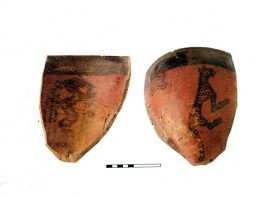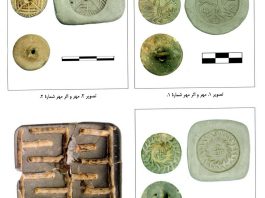Name
Qara Tepe, Qomrūd قره تپه، قمرود
Ali Mousavi
Location: Qara Tepe is a mound 2 km southwest of the large village of Qomrūd, and 25 km north of the city of Qom in central-northern Iran, the Qom Province.
34°43’08.6″N 51°03’06.9″E
Map
Neolithic
Qara Tepe is an archaeological mound located 1 km southwest of the village of Qomrūd. The mound is approximately 11 m high and roughly rectangular (320 x 275 m).
The excavations at the site revealed 7 archaeological levels. Level 1 includes the uppermost occupation of the site. Because of natural erosion and human re-occupation, the remains of this level are limited to eroded floors and a few potsherds. The date of this level is uncertain but a date in the Early Bronze Age (c. 3000-2500 B.C.) is possible. Level 2 covers 400 m² of the excavated area with an abundance of ovens and hearths. Level 2 also yielded stamp seals. The presence of fine pottery similar to the Cheshemh-Ali Ware in Reyy suggests a date around 4000 B.C. But, there is also distinct pottery that cannot be found in other neighboring sites such as Tepe Sialk and Cheshmeh-Ali. Level 2 represents a distinct archaeological period. Level 3 follows the upper level with no gap. The architecture of this period includes three distinct complexes built around a central area. Ovens were found among the remains of this period. Mud-brick walls and floors were plastered. The pottery is predominantly buff ware reminiscent of the Bakun Ware in Fars. Level 3 suddenly ended because of either a general fire or an earthquake. Level 4 remains consists of scattered architectural units with some large structures with decoration and fully plastered walls and floors. Several posts holding possibly a roof were discovered in this building. A fireplace and traces of carbonized beams suggest that the building was a prominent construction. Pottery is painted buff-ware much the same as those found in the plain of Susiana and Bakun in the south. The presence of pieces of copper shows that the community of this period was involved in trade and or extraction of metals. Level 5 follows the upper level without stratigraphic interruption. The architectural remains are, however, different in that they do not seem to follow an organized plan or pattern (fig. 1). The large structure of Level 4 survived well into this level. Pottery is a mixture of red and buff ware. Level 6 is encountered beneath a thick deposit of debris and the household refuses. Structures were solidly built and pottery is of higher quality in terms of firing and decoration. The remains of Level 7 are exposed in a small area that was part of a large rectangular room with two doors. This level includes the same painted pottery of previous levels, and there were pieces of copper.
Archaeological Exploration
Qara Tepe was excavated by Mirabedin Kaboli on behalf of the Iranian Center for Archaeological Research for seven seasons from 1994 to 2001.
Bibliography
Kaboli, M., Excavations at Qara Tepe, Qomrūd, Tehran, 1394/2015.





 DOWNLOAD AS PDF
DOWNLOAD AS PDF

















































































































